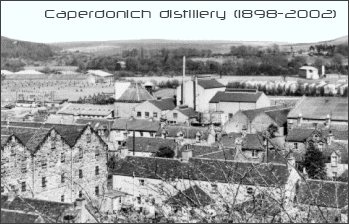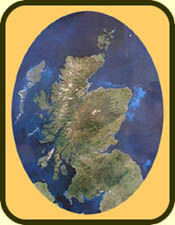Caperdonich whisky


Caperdonich Scotch Whisky
Caperdonich (Pronounced: CAP-per-DON-nik)
Speyside (Rothes)
57°32'11.76"N, 3°12'51.74"W
Glen Grant, Glenrothes, Glen Spey
Mothballed (in 2002)
1897 or 1898
Caperdonich Burn
2 Wash stills, 2 Spirit stills
None - Caperdonich was mothballed in 2002
Pernod Ricard > Chivas Group (since 1989)
Rothes, Morayshire AB38 7BS, Scotland
-
No
No
No
Below, on WhiskyFun and on the Malt Maniacs Monitor
Name:
Region:
GPS location:
Neighbours:
Founded:
Status:
Water source:
Equipment:
Production capacity:
Ownership:
Address:
Telephone number:
Visitor centre:
Website:
Official bottlings:
Scores & tasting notes:
Caperdonich distillery started its life in 1898 under the
(relatively uninspiring) name 'Glen Grant #2'. Caperdonich
distillery was founded by J. & J. Grant, the people that also
built the 'original' Glen Grant distillery in 1840. This brand
new whisky distillery (which was built at the height of the
whisky boom of the late 19th century) was conveniently
located just accross the street from Glen Grant in Rothes.
(Other neigbours include Glenrothes and Glen Spey.)
Both 'sister' distilleries are located at the northern end of
Moraytown Village in
Rothes, but only one of them operated
continuously until the present day. Caperdonich closed its
doors again in 1902, a mere four years after the distillery
was opened. This 'false start' in the Scotch whisky
world
was caused by the after-effects of the Pattison Crisis that
caused panic in Scotland around the turn of the century.
In a way, it was not unlike the
credit crisis of 2008...

Nevertheless, during the early years Caperdonich didn't manage to become as popular as Glen Grant - hence the closure in 1902. But that wasn't the only reason - Caperdonich was one of the distilleries
that was hit hardest by the effects of the collapse of the whisky empire of the Pattison brothers from Leith. The Pattison crisis was the start of a general downturn in the whisky industry; during this period the number of
operating distilleries in Scotland dropped from 191 at the end of the 19th century to 132 in 1908.
Glen Grant Number Two remained inactive for six decades, but in the year 1965
it was rebuilt by Glenlivet Distilleries Ltd. who resumed production. The new owners also changed the name to Caperdonich
("Secret Well") - but this wasn't entirely voluntary. A new law prohibited the use of the same name for different whisky distilleries that were operational at the same time, so the owners had to find an alternative for 'Glen Grant #2'.
In 1977 Seagram from Canada acquired Caperdonich distillery - before selling it on
to Pernod Ricard in 2001. Pernod Ricard closed the distillery one year later in 2002,
together with three of its sister distilleries; Alt A' Bhainne, Braeval (Braes of Glenlivet)
and Benriach. At the end of the decennium Caperdonich was the only distillery from
this group that hadn't been reopened yet. The longer a whisky distillery remains
inactive, the higher the costs of making it operational again. This sad fact makes it
ever more unlikely that the Caperdonich distillery
will ever be reopened again.
So, it's hardly surprising that Seagram's used the malt whisky that was produced at Caperdonich distillery mainly for their blended whiskies like Passport, Chivas Regal, Something Special and Queen Anne. As a result, there are no official bottlings of Caperdonich.
Well, at least not that I know of; there is one Caperdonich 16yo 1988/2005 (55.8%, OB, Chivas Brothers) on the MMMonitor.
There have been a handful of independent releases
by independent bottlers like Douglas Laing , Duncan Taylor and Gordon & MacPhail, but
those are fairly hard to find.
Sometimes bottlings can be quite unique though, like a Caperdonich 10yo 1998/2008 by Alambic Classique, which apparently was made from a very rare peated batch.
That's the story of the
Caperdonich in a nutshell...

1) Caperdonich was a key component in some Chivas Regal blends - just like the Strathisla malt whisky.
2) Caperdonich produced 350,000 gallons of spirit in its first year after reopening.
3) When the Caperdonich distillery was renovated in 1967, two additional steam heated pot stills were added to the original two. Advancements in technology and a modern, state-of-the-art tun room enabled the entire distillery to be run by just one or two people.
4) The famous 'whisky pipe' which was placed above the street to carry spirit between Caperdonich and Glen Grant was responsible for an odd variety of the so-called 'angels share'. Locals took advantage of the easy access to this famous pipe, drilled holes in it and took spirit for their own. According to Lawrence Graham the legendary pipe was installed on the insistence of the British Customs & Excise.
5) The water source for both the Glen Grant and Caperdonich distilleries is Caperdonich Burn.
Caperdonich 37yo 1972/2010 (53.4%, Duncan Taylor Rare Auld, Cask #7420, 136 Bts.)
Nose: Aah! Rich and sweet with hints of smoke and marzipan. Very enjoyable. Opens up over time.
Roasted nuts. With a splash of water the bouquet grew more polished, softening some rough edges.
Taste: Sweet and smoky with an undercurrent of tropical fruits. Something vaguely perfumy. Touch of peat?
Score: 90 points
- I had it at 90 points for a long time, but in the end it was a tad too sharp in the finish.
Caperdonich 36yo 1972/2009 (54.4%, Whisky Doris, Bourbon Hogshead #7425, 175 Bts.)
Nose: Polished. Fruity start before it takes a farmier direction. Prickle in the back of the nose. Maggi?
Rum filled dark chocolates. Then more fruits and some subtle organics emerge. Evolving complexity.
Taste: Fruity start; quite solid but rather undefined. Smooth, fairly strong centre, growing grittier later on.
The fruits hang around in the centre and finish as well, slowly evolving into tannins. Dry, plywood finish.
Score: 83 points - the nose deserves a score in the upper 80's in my book, but the palate doesn't.
Caperdonich 1972/2008 (49.9%, G&M for La Maison du Whisky, first fill sherry butt, C#1976)
Nose: Polished, fruity and woody. Sweet & sour notes. A classic profile with some rough edges.
Hard to score - I love this sort of profile, but the wood is too dominant. Water makes it cloudy. Some tar?
Roasted nuts. Coffee? It really pays off if you allow this one to breathe for half an hour or longer.
Taste: Woody start, gradually giving more room for old fruits in the centre. very powerful tannins.
Cough syrup. Mouth coating. A decent amount of smoke. The wood returns with full force in the finish.
The wood grows a little overpowering in the end. The lightest touch of peat after adding a few drops of water.
Score: 85 points - I love the liquorice and smoke on the palate. A little too much wood though.
Caperdonich 38yo 1968/2007 (54.2%, Duncan Taylor for The Nectar, cask #2609, 130 bottles)
Nose: Nondescript. Glue. Then tropical fruits (pineapple, passion fruit) which for me usually indicates old age.
Taste: Faintly swee, exploding into complexity - although I still found a hint of perfume in the finish.
Score: 88 points - one of a few dozen 'high flyers' in the 2007 edition of the Malt Maniacs Awards.
Caperdonich 34yo 1972/2007 (53.4%, Duncan Taylor for LMDW, From Huntly to Paris, cask #6707, 210 bottles)
Nose: Strange. Alcoholic. Hardly any character. I'd love to write more, but I'm afraid that I really can't...
Taste: Weird, uneven start. Sweet, coffee centre. Bitter finish - perhaps a hint of smoke? Liquorice over time.
Can't make heads or tails of this one. It grew on me over time, though - earns most points on the palate.
Score: 78 points - a nice enough drinking whisky that I wouldn't actively recommend.
Caperdonich 37yo 1968/2006 (40.3%, Duncan Taylor / Lonach)
Nose: Malty with a hint of fruits. Very 'friendly' and quite clean. Faint menthos? Hint of string beans.
Taste: Oooh... Terribly soft-spoken. Seems hardly like 40%. Pleasant and easily drinkable, though...
Score: 77 points - better than 'average', but not quite what I expected at this ripe old age.
Caperdonich 36yo 1967/2004 (57,9%, Douglas Laing Platinum, 167 Bottles)
The proof seems unusually high for a bottle this old - or for a Douglas Laing 'Platinum' for that matter.
Nose: Very rich and sherried at first, settling down after a few seconds. Very nice but not terribly complex.
Adding water didn't seem to work very well, but after a minute the original profile returned - but nothing more.
Taste: Fruity start, followed by a fairly mellow centre. Berries. Growing tannins (grape skins) in the finish.
Just like the nose, it doesn't seem terribly complex - and maybe just a tad too bitter in the end for me.
Score: 86 points - I had it in the very upper 80's for a while, but after a while it starts to fall apart.
After approximately five minutes the harsh woody notes had taken over the palate completely.
Caperdonich 30yo 1972/2003 (50.1%, Hart Brothers Finest Collection, 11/72, 05/03)
Nose: Quite unique with wassabi and vinegar. Next, organics join the party - and more wassabi.
Then soy sauce - Kikkoman? Later on I got lemon as well, before it sweetens out. Nice! With a palate to match the nose it might have made the 90's, but to me it didn't entirely live up to my expectations.
Taste: It started off quite dry, grew sweeter in the centre and then turned a little bit dry again in the finish.
Score: 88 points
- and Davin liked it even better and put it at 90 points exactly. A very fine dram indeed.
Caperdonich 24yo 1977/2002 (57.3%, Cadenhead's Authentic, 666 Bottles)
Nose: Very sherried. Rich and round. Lots of character with spicy episodes.
Taste: fruity and chewy; big with a hint of smoke.
Score: 86 points - proves my suspicions that this stands age just as well as Glen Grant.
Caperdonich 31yo 1970 (52.3%, Caledonian Selection)
Nose: Big & Sweet. Develops to spices and 'herbs the provence'. Some smoke? Very appealing.
Taste: Resinous. Somehow feels a bit like a finished malt. Sourish in the finish. Tannins. Quite chewy.
Score: 83 points - this one starts out very promising in the nose but loses a few points on the palate.
Caperdonich 1980/1998 (40%, G&M Connoisseur's Choice, 70cl)
Nose: Light, fruity & smooth. Early fruits (Apple?) evolving into older fruits. Faint hint of peat and smoke.
Taste: Quite rough on the tongue at first. Wood. The finish develops into a long sweety/salty burn.
Score: 75 points - the style of the bottler is more apparent than the style of the distillery.
Caperdonich 16yo 1972/1988 (40%, Signatory Vintage, C#7130-7132)
Nose: Wow!!! Lots of organics, beautifully combined with sherry. Then fruits. Unoffensive perfume.
Taste: Hmmmm... Not bad, but a little watery. Smoke, growing stronger. Something perfumy too.
Score: 88 points - proof that obscure distilleries can deliver.
Caperdonich 1968 (40%, G&M Connoisseurs Choice, Old Brown Label, Bottled +/- 1983)
Nose: Maybe peanut. Growing complexity, but it doesn't really pick a specific direction. Marzipan.
Mocca. Mushroomy. Very pleasant in the nose, but last time I tried it the palate didn't back it up.
Palate: Old and tired on the palate. Sweet, but nothing else. Feels rather weak at 40%.
Score: 78 points
- earned almost exclusively by the nose.
And there's more to tell about Caperdonich...
These were not all (official & independent) bottlings of Caperdonich Scotch whisky I've tried over the years.
Besides, these tasting notes only reflect my own, personal opinion; your tastes might be different from mine.
Fortunately, you can find the scores and tasting notes from up to two dozen other whisky lovers in the 'Malt Maniacs
Monitor' - an independent whisky database with details on more than 15,000 different whiskies from Scotland and the rest of the world. Visit the Caperdonich page on the MMMonitor and select 'scorecard view' if you want to know
how other whisky lovers felt about the dozens of Caperdonich expressions that have been released in recent years. However, if you'd like to learn more about whisky in general (and single malt Scotch whisky
in particular), you might want to check out the Beginner's Guide to Scotch whisky (10 chapters filled with everything you need to fully enjoy
and appreciate a glass of single malt whisky) or the mAlmanac (sort of a rudimentary whisky shopping guide.)

2001 - Seagram's (who acquired Caperdonich in 1977) sold the distillery to Pernod Ricard.
2002
- Pernod Ricard decided to close Caperdonich one year after they acquired the distillery. They also closed the three distilleries they purchased at the same time; Alt A' Bhainne, Benriach and Braeval (a.k.a. Braes of Glenlivet). Those three distilleries were re-opened within a few years, but the same was not true for Caperdonich.
2010
- I've heard rumours that the old buildings of Caperdonich have been repurposed for good.


After the Caperdonich distillery was closed in 1902, much of the distillery equipment was transferred to the nearby Glen Grant distillery to be used as spares. When it came to the copper pot stills, this was easy enough - the size and shape of the stills at Caperdonich was virtually identical to that of the stills at Glen Grant. In fact, the owners of the distillery also used the same water source and malted barley supplier as Glen Grant in an effort to mimic the quality and style of the popular Glen Grant malt whisky.
In 1965, after having been silent for nearly 65 years, Caperdonich was rebuilt by new
owners (the Glenlivet & Glen Grant Distillers Ltd.). It wasn't long before the distillery
was producing
whisky again; in its first year Caperdonich produced 350,000 gallons
of spirit. In 1967, the Caperdonich distillery was expanded by the installation of two
extra stills; two brand new steam heated pot stills. Furthermore a modern tun room
was added. The installation of the latest technology made it possible for the distillery
to be operated by
a staff of only two people. A third of the required malted barley
was produced at Glen Grant distillery; the rest was brought in from other sources.
Another reason that the resurrection of Caperdonich is unlikely, is the reputation
of the whisky that is distilled there. Like the original name 'Glen Grant Number Two'
and the famous
'whisky pipe' that ran between Capedonich and Glen Grant suggest,
Caperdonich was intended more like a production expansion for Glen Grant, and not
so much as a brand new malt whisky distillery.



|
|
|
|
|
DD Overview |
|
|
|






